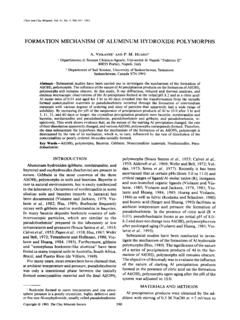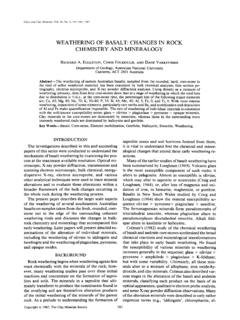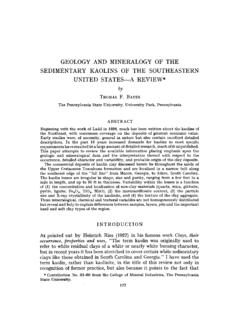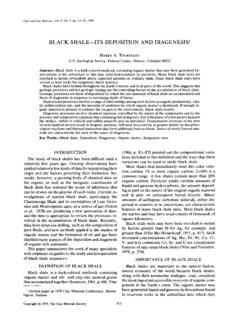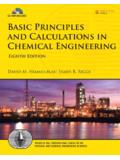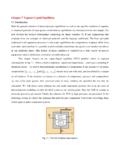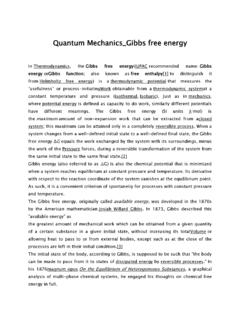Transcription of THERMODYNAMICS OF THE VARIOUS HIGH TEMPERATURE ...
1 THERMODYNAMICS OF THE VARIOUS . high TEMPERATURE TRANSFORMATIONS. OF kaolinite . by N. C. ScHiELTZ* and M. R. SoLiMANf ABSTRACT. THERMODYNAMIC calculations of AG for all possible transformations of metakaolin a t the TEMPERATURE of t h e first DTA exothermic peak indicates t h a t the most stable trans- formation is the one t h a t yields mullite rather than y-alumina. The energy of crystalUzation of y-alumina is quite small 36,513 cal per mol, com- pared with the energy of crystallization of mullite 336,180 cal per mol. Furthermore, the crystallization of y-alumina is very slow, and t h e crystal growth never produces crystallite sizes much larger than the lower end of the colloidal region. Hence, the gradual release of the small amounts of energy liberated during the crystallization of y-alumina would be extremely difficult to detect by DTA methods. INTRODUCTION. ALTHOUGH the kaolinite -muUite transformation series has been the subject of extensive investigations, some fundamental problems still remain unsolved.
2 The interpretation of the first exothermic peak that is observed in the DTA. of kaolinite at about 980 C is still a matter of speculation. It is a well-known fact that kaolinite , Al2032Si022H20, undergoes some significant changes in its structure when heated to higher temperatures . It loses its (OH) lattice water between 500 -600 C. This loss of lattice water breaks up the regular periodicity in the kaolinite structure along the c-aj^is producing a dehydrated phase known as metakaolin. By further heating, metakaolin transforms to a crystalline phase or phases, indicated by the first exothermic peak at about 980 C. This phase or these phases are still a point of dispute among different investigators. Insley and Ewell (1935), Jay (1939), Hyslop (1944) and Richardson and Wild (1952) report y-alumina as the product phase of fired kaolinite at 980 C. Comeforo, Fisher, and Bradley (1948), Johns (1953) and Brindley and Hunter (1955) report mullite as the product phase of fired kaolinite that was responsible for the first exothermic DTA peak at about 980 C.
3 * Colorado School of Mines, Golden, Colorado. t Ministry of Industry, Geological Survey and Mineral Research Department, Cairo, Egypt. 419. 420 THIRTEENTH NATIONAL CONFERENCE ON CLAYS AND CLAY MINERALS. D E T A I L E D STUDY OF K A O L I N I T E - M U L L I T E. transformation SERIES. In this investigation, experimental laboratory work was combined with a thermodynamic approach in an attempt to explain the first exothermic DTA peak of kaolinite . A detailed study of the kaolinite -muHite transfor- mation series was made over the range 950 -1500 C. The transformations were followed by means of X-ray analysis at TEMPERATURE intervals as small as 10 C in the neighborhood of the first exothermic peak. The heating time was varied between 5 min and several hours. Studies on different kaolinite minerals* and one halloysite sample showed that y-alumina was always forming before mullite| and at longer heating times it was found that both y-alumina and mullite coexisted as product phases of fired kaolinite between 950 -1100 C| (Plate 1).
4 In all X-ray patterns of y-alumina, the lines were always very broad and diffuse, even after heating for as long as 28 hr and furnace cooling. This indicates that y-alumina never develops into a well-crystallized phase as compared to mullite. The y-alumina phase could never be identified on a diffractometer trace. It was also found that y-alumina lines were shifted compared with the lines of the standard pattern, indicating a spinel-type phase as reported by Brindley and Nakahira (1958). In spite of the fact that both y-alumina and mullite coexist as product phases of fired kaolinite , the question concerning the source of the first DTA. exothermic peak still remains: Which phase is responsible for the first exo- thermic peak? Is it y-alumina or mullite or both? Thermodynamic Data for kaolinite and its Products Vaughan (1955) reported that the values of heats of formation of meta- kaolin, mullite and y-alumina were given by Avgustinik and Mchedlov- Petrosyan in 1952 as -767,500, -1,804,000 and -391,290 cal per mol.
5 The values reported by Kroger in 1953 (Vaughan, 1955) are: 803,000, 1,804,000 and 395,000 cal per mol respectively, for the same substances. The value for the heat of formation of metakaolin, 767,500 cal per mol, is also listed in the Handbook of Chemistry and Physics (1959; 1960. The heat of formation of kaolinite was estimated by Vaughan (1955) as 964,000 cal per mol and as 964,940 cal per mol by Budnikov and * The kaolinite minerals were: (1) , produced by the Edgar Plastic Kaolin Company, Edgar, Florida, code no. CT-108-1. (2) Mallinckrodt kaolinite produced by the Mallinckrodt Chemical Works, St. Louis, Mo., code no. 5643, lot no. KH520. (3) 9b. kaolinite , Reference Clay Minerals, Research Project 49. (4). Halloysite, Ureka, Utah, Research Project 49. t The X-ray patterns made at room TEMPERATURE of kaolinites and halloysite t h a t had been heated a t 950 C from 2 0 ^ 0 min showed small crystallites of a-quartz prior to the formation of y-alumina, which appeared after about 1 hr heating time at 950 C.)
6 X The TEMPERATURE range where both y-alumina and mullite coexist, 950 -1100 C, is for only; for other minerals this TEMPERATURE range is slightly different, since it depends on the type of mineral used. I'LATE 1. Coexistence of y-alumna and mullite at different temperatures . THERMODYNAMICS OF H I G H TEMPERATURE TRANSFORMATIONS 421. M c h e d l o v - P e t r o s y a n (1960). T h e y also d e t e r m i n e d t h e h e a t c a p a c i t y of k a o l i n i t e from t h e o x i d e s a n d w a t e r v a l u e s . T h e t h e r m o d y n a m i c d a t a for different p h a s e s of silica a n d w a t e r w e r e r e p o r t e d b y K e l l y ( I 9 6 0 ) , K u b a s c h - e w s k i a n d E v a n s (1951), C o u g h l i n (1954) a n d G l a s s n e r (1959). T a b l e 1 lists t h e m o s t r e l i a b l e v a l u e s of t h e t h e r m o d y n a m i c p r o p e r t i e s of kaolinite a n d its p r o d u c t s.
7 TABLE 1. VALUES OF THERMODYNAMIC P R O P E R T I E S S^^g, Ail^ajg AND Cp FOR K A O L I N I T E. AND I T S PRODUCTS. Substance AH . kaolinite 964,940 + XlO-^r xlO'^r-^. Metakaolin 767,500 5 4 . 8 5 + XlO-^r x l O ^ r - a Mullite 1,804,000 + x l O - T 2 5 . 0 0 x l O ^ r - 2. y-Alumina 395,000 + 1 1 . 1 0 x i o - r a-Quartz 209,900 1 1 . 2 2 + x l O - T 2 . 7 0 XlO^^r-^. |8-Quartz 209,900 + 1 . 9 4 x l 0 - = r SiOj (glass) 202,000 1 3 . 3 8 + XlO-T xlO^^r-i! a-Cristobalite 209,550 + x l O - T. i8-Cristobalite 209,550 + X l O - T. a-Tridymite 209,400 + X l O - s r i8-Tridymite 209,400 + X 10-^T. HjO (water) 68,320 HjO (steam) 57,800 + 2 , 5 6 x l 0 - 3 r + 0 . 0 8 x l 0 ^ r - 2. Possible Transformations of Metakaolin If o n e e x a m i n e s t h e l i t e r a t u r e , h e will find t h a t s o m e i n v e s t i g a t o r s o b s e r v e d y - a l u m i n a ; o t h e r s o b s e r v e d m u l l i t e ; a n d a few o b s e r v e d b o t h.
8 C o n s e q u e n t l y , i n t h i s i n v e s t i g a t i o n , all possible t r a n s f o r m a t i o n s of m e t a k a o l i n w e r e c o n - s i d e r e d . T h e s e t r a n s f o r m a t i o n s a r e s h o w n in T a b l e 2. TABLE 2. POSSIBLE TRANSFORMATIONS OF METAKAOLIN AND THE CORRESPONDING. VALUES OF AG AT 1250 K. transformation - AGi, 60 K. 1. Al2032Si02 ^ AI2O3 (y) + 2 SiOj (glass) 24,150. 2. Al2032Si02 ^ AI2O3 (y) + 2 SiO (crystalline) 40,919. 3. Al2032Si02 v^ 1/3 (3AI2O325102) + 4/3 SiOj (glass) 93,834. 4. Al2032 SiOa ^ 1/3 (3Al2032Si02) + 4/3 SiO^ (crystalline) 105,022. 5. Al2032Si02 ^ 1/4 (3Al2032Si02) + 1/4 A-hO^iy) + 3/2 SiO^ (glass) 6. Al2032Si02 ^ 1/4 (3Al2032Si02) + 1/4 Al203(7) + 3/2 SiOa (cryst) 88,991. S u b s t i t u t i n g t h e d a t a of T a b l e 1 i n t o t h e G i b b s free e n e r g y e q u a t i o n * : T T. AGT = AH,,, + J ACpdT - T AS,,, - T j ACpdT/T (1).
9 298. * Gibbs free energy equation is defined by Kubaschewski and Evans (1951, p. 25). 422 THIRTEENTH NATIONAL CONFERENCE ON CLAYS AND CLAY MINERALS. equations for AG as a function of T were obtained for all possible transforma- tions shown in Table 2. Since SiOg is a possible product, all phase transitions of silica from a-quartz to fused silica had to be considered in obtaining the AG equations for trans- formations 2, 4, and 6. The SiOg phases and their transition data are given in Table 3. AG equations for the phase transition of silica are listed in Table 4. T A B L E 3. temperatures AND H E A T S OF TRANSITIONS OF D I F F E R E N T PHASES OF. SILICA. Phase TEMPERATURE range AH( cal/mol a-Quartz 298 - 848'>K. 290. /3-Quartz 848 -1140 K. 180. /S-Tridymite 1140 -1743 K. 30. y3-Cristobalite 1743 -1953 K. 2150. Glass 1953 -2100 K. T A B L E 4. AG EQUATIONS FOR THE VARIOUS P H A S E TRANSITIONS OF SILICA.)
10 SiOj (a-quartz) ^ SiOj (/3-quartz). AG = + T ~ T l n T + 3 . 1 3 x l O - r 2 - 1 . 3 5 x l 0 5 r - i SiOa (;S-quartz) v^ SiO^ (/S-tridymite). AG = - T + T l n T - x lO-^T^. SiOj (/S-tridymite) ^ SiOj (;S-cristobalite). AG = + T ~ T l n T + 0 . 3 0 x l 0 - ' r 2. SiOj (/3-cristobalite) ^ SiOa (glass). AG = 8 3 7 . 7 6 0 - T - | - 1 . 0 2 0 T l n T - xlO-^T^ x l O ^ T - i The AG equations for all possible transformations are listed in Table 5 for the different TEMPERATURE ranges between 298 -2100 K ( of muUite). Table 6 gives the Affy equations for the different transformations. Table 7. gives the Aifr equations of the phase transitions of silica up to j8-tridymite. The Most Stable transformation The calculated values of AG of the different transformations have been plotted against TEMPERATURE as shown in Fig. 1. Since the reaction that has the maximum AG is the most stable, we find that transformation 4, being the one with the highest AG, is the most stable.


